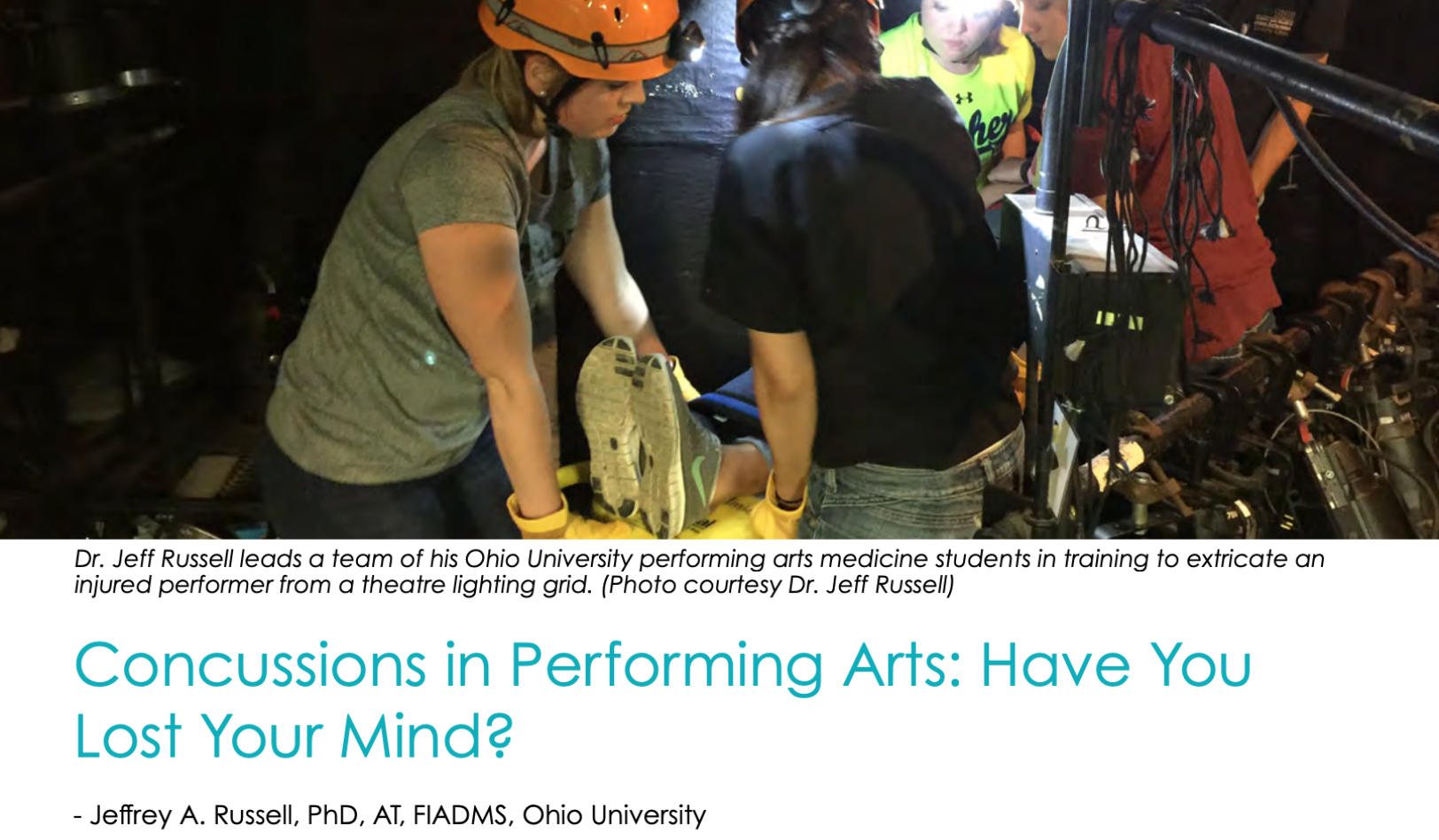Concussions are as much a performing artist’s concern as a football player’s, or hockey player’s, or rugby player’s. Few injuries are as well publicized in sport than concussions. It can be a scary injury, especially when we regularly see its unfortunate consequences. Yet, for all the voices raised to reduce head injury in sport, why is the auditorium virtually silent about the same injury in performing arts?
– Jeffrey A. Russell, PhD, AT, FIADMS, Ohio University
Are performers’ brains less important? A concussion is, after all, an injury to one’s brain. (In fact, another name for concussion is traumatic brain injury.) You know…your brain is the thing inside your skull that cannot be replaced and that controls almost everything in your body. Obviously it is quite an important organ, yet who advocates for our brains in theatres, studios, film sets, and concert venues? The only known research study on head injuries in theatre reported that two-thirds of theatre personnel have sustained a head impact in their career and more than three-quarters of those reported three or more. We are dealing with a big issue.
The subtitle of this article, “Have You Lost Your Mind?” is quite significant. Indeed the research is clear: you might truly lose it if you ignore appropriate care for a concussion. Too many athletes and performing artists avoid reporting their concussions in spite of the dangers of doing so, dangers like longer recovery, increased risk of subsequent concussions, longterm disability, or worse.
“The show must go on,” a lack of understudies, not wanting to appear weak, “I feel fine, it’s no big deal,” or other excuses are not sufficient reasons to willfully neglect the suitable management of a head impact. On the other hand, being out of work and, therefore, unpaid because of a concussion is a real dilemma. In short, performers and other workers in performing arts environments need caring, compassionate, dependable advocates, starting with those immediately around them.
Alright then, I hope you have decided to become more knowledgeable about concussions and their care. In that case, preparing yourself and your team members is essential. Here are some steps you should take:
1. Obtain and review the Concussion Recognition Tool (CRT5) that is available for free at http://bit.ly/concussiontool5. It is an easy to use one-page document for nonmedical professionals to help identify the signs and symptoms that may indicate a concussion. Laminate some copies and keep them in key locations at your workplace.
2. Take free online concussion training from my friends at cattonline.com. Their Concussion Awareness Training Tool is excellent, and they have a “Workers and Workplaces” module. In addition, cattonline.com exhibit at Actsafe annual conferences, so you’ll be supporting a supporter of Actsafe!
3. Ensure that first aiders who staff your venue have received training in managing concussions.
4. Identify medical personnel and clinics in your community who are equipped to manage concussions with current “best practices.”
5. Create a culture of “It’s okay to report head impacts” in your workplace and develop a method for reporting. Research shows that people understanding how and to whom they should report possible concussions increases the likelihood they will do so. Now let’s say that someone in your performing arts workplace receives an impact to their head. Use YOUR head to take care of THEIRS by following a few simple guidelines:
1. Implement the Concussion Recognition Tool to assess the individual’s status. Just follow the CRT5’s instructions. Remember, you are not making a medical diagnosis; rather, this step provides an initial evaluation of whether an individual should be referred for medical care.
2. Remove the individual from activity for the remainder of the day if the CRT5 suggests the possibility of a concussion.
3. Personally ensure that the injured person is evaluated by a qualified healthcare practitioner, keeping in mind that research shows that not all medical professionals understand how to direct concussion care. There are some excellent resources to guide healthcare workers.1 (These will have to be “translated” from the language of sports, however.)
4. Support the individual in any way possible—including connecting them to workers’ advocacy organizations—realizing that the road back from a head injury may have many twists and turns. With regard to the CRT5, you’ll see that it is designed for sports, including language like “game” and “who scored.” Do not be dismayed; we simply change those to “performance” or “event” or “who performed.” For example, one CRT5 memory assessment question is “What team did you play last week/game?” To apply that to a performing arts situation, we would ask someone who received a blow to the head, “What performance event did we hold last week?” or “Who was the lead performer in last week’s performance?”
In summary, enacting and staying focused on proper protocols when a head impact occurs at your worksite is crucial to everyone’s success and good health. EVERY impact to someone’s head is important so that we don’t lose any more minds.
This article was written for our quarterly newsletter, Safety Scene. You can find a link to the full edition below.




Share Now: